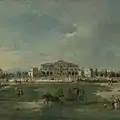Loredan
The family of Loredan (Italian: [loreˈdan], Venetian: [loɾeˈdaŋ]) is a noble family of the Republic of Venice. Throughout history, the family has produced a number of famous personalities: doges, members of various state councils, procurators, providures, podestàs, military commanders, naval captains, church dignitaries, writers and lawyers.
| House of Loredan | |
|---|---|
| Noble Family | |
 Coat of Arms of the House of Loredan | |
| Country | |
| Etymology | from Lauretati, due to their ancestors' historical glory |
| Place of origin | Loreo, Veneto |
| Founded | 11th century, possibly earlier |
| Style(s) | "His Serenity" |
| Members | |
| Traditions | Roman Catholicism |
| Motto | NON NOBIS DOMINE NON NOBIS ("Praise us not, O Lord.") |
| Estate(s) | |
The family has played an important role in the expansion and development of the Republic of Venice, and has been prominent and influential in the entire Mediterranean. It was significant in the War of the League of Cambrai and its members distinguished themselves in defending Europe from the Ottoman conquests in the Ottoman-Venetian wars. The family has also played a crucial role in the creation of modern opera with the Accademia degli Incogniti, also called the Loredanian Academy.
Origin
The origin of the family is not completely clear.
Some historians traced the origin of the family back to the Mainardi family, in turn descended from Gaius Mucius Scaevola. They then acquired the surname of Lauretati, Lauretani, Loredani because of their ancestors’ historical glory. Also, according to legend, they founded the city of Loreo in 816 AD, and moved to the Venetian Lagoon in 1015 AD. The first written references of the family, however, date from the 11th century.
Another theory is that they originate from the town of Bertinoro near Cesena, in Emilia-Romagna, from where they moved to Venice.
The family was organised and divided into multiple branches. The family branch of Santo Stefano ended with Andrea di Girolamo Loredan in 1750. The branch of San Vio (with the Palazzo Loredan Cini) still exists today.
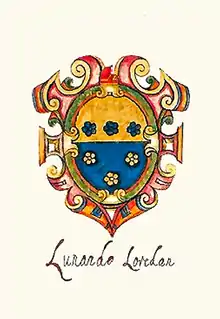
History
13th century
The Loredan family has been occupying hereditary seats on the Great Council since the Serrata del Maggior Consiglio of 1297, by which the membership in the Great Council of Venice became a hereditary title, and was limited to the families inscribed in the Golden Book of Italian nobility. This resulted in the exclusion of minor aristocrats and plebeians from participating in the Government of the Republic.
14th century
Marco Loredan, who lived in the 14th century was elected as Procurator of Saint Mark's, one of the highest political positions in the Venetian Republic, and was one of the electors of Doge Andrea Dandolo. Contemporary to him are Paolo Loredan, who distinguished himself in the highest military positions of land and sea, and Alvise Loredan, who also became Procurator of Saint Mark’s.[1]
15th century
One of the important members of the family in the 15th century was Pietro Loredan, who was three times Captain General of the Sea; in 1416 he conquered several Dalmatian strongholds and later defeated the Ottomans at Gallipoli, capturing fifteen galleys; in 1431 he defeated the Genoese and Milanese in Rapallo, achieving the capture of eight galleys and General Francesco Spinola. Pietro died in 1439.
His son Giacomo Loredan was a general and defeated the Ottomans in 1464.
Also significant at this time was Alvise Loredan (1393-1466), who became a galley captain at a young age and served with distinction as a military commander, with a long record of battles against the Ottomans, from the naval expeditions to aid Thessalonica, to the Crusade of Varna, and the opening stages of the Ottoman-Venetian war, as well as the Wars in Lombardy against the Duchy of Milan. He also served in a number of high government positions, as provincial governor, Savio del Consiglio, and Procuratore de Supra of Saint Mark’s Basilica. He died in Venice on the 6th of March 1466, and was buried in the Church of Santa Maria dei Servi.
In that same century, Luigi, Giacomo and Antonio Loredan, all Procurators of Saint Mark, distinguished themselves with important political positions.
Leonardo Loredan, born in 1436 to Gerolamo Loredan di S. Vitale, was the first doge of the Loredan family. He had a good classical education, focusing on literature, after which he devoted himself to trade in Africa and the Levant to increase the family’s finances. In 1461, he married Giustina Giustiniani, of the wealthy branch of S. Moisè, with whom he had nine children: Lorenzo (who became Procurator of St. Mark's), Girolamo (the only one to continue the branch), Alvise, Vincenzo (died in Tripoli in 1499), Bernardo, Donata, Maria (wife of Giovanni Venier, of the branch that gave birth to Doge Francesco Venier), Paola (wife of Giovanni Alvise Venier, descendant of Doge Antonio Venier), and Elisabetta.[2]
Leonardo’s political ascent began at the age of nineteen, when he became a lawyer in the “Giudici di Petizion”, a magistracy concerned mainly with financial scandals and bankruptcies, for which he had Filippo Loredan as guarantor. During his political career, he held multiple high positions such as chamberlain of the Comùn, wise man of the Council, podestà of Padua, and Procurator of Saint Mark's.
_-_Statue_of_doge_Leonardo_Loredan.jpg.webp)
On the 31st of March, 1495, he was one of the three designated by Doge Agostino Barbarigo to negotiate the alliance between Venice, Pope Alexander VI, Holy Roman Emperor Maximilian I of Habsburg, the Spanish rulers Ferdinand V and Isabella I and the Duke of Milan Ludovico Maria Sforza (King Henry VII of England also joined), with the aim of countering the military operations of the King of France Charles VIII who had, almost without encountering military resistance, entered Naples in February. The army of the League, led by the Marquis of Mantua Francesco II Gonzaga, in the Battle of Fornovo on the 6th of July forced the French army to withdraw from Italian territory. In October of the same year, Loredan signed the agreement for the conduct of Niccolò Orsini, count of Pitigliano, to the services of the Republic of Venice as governor general of the land militias for the period of three to four years. In January of 1497, Loredan, with the wise man of the Terraferma Lodovico Venier, ratified the surrender of Taranto on behalf of the Doge.
16th century
On the death of Doge Agostino Barbarigo (20th September, 1501), Leonardo Loredan was one of the designated candidates in the election of the new doge, which began on the 27th of September and ended on the 2nd of October with Loredan coming out first with 27 votes in the sixth hand of the first ballot. The election was successful thanks to his and his wife’s influential relations and the sudden death of the most popular opponent, the wealthy procurator Filippo Tron, son of Doge Nicolò Tron. Leonardo became the 75th Doge of the Venetian Republic and his dogeship is considered one of the most important in the history of Venice.
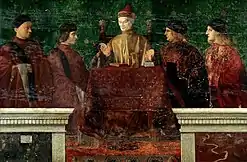
Ottoman-Venetian War
At the time of his accession to the dogeship, Venice was engaged in the second Ottoman-Venetian war, and Leonardo had lost his cousin Andrea Loredan, a naval officer, in the disastrous Battle of Zonchio. The war proceeded badly on land too, with the Venetians losing considerable territory. This included the strategic city of Modon, which was the site of a bloody battle involving hand-to-hand combat, followed by the beheading of hundreds of Venetians following the Turkish victory. The war took a heavy toll on the Venetian economy, and in 1502/1503 Loredan agreed a peace treaty with the Ottomans. He was helped in negotiations by Andrea Gritti, a Venetian who had been conducting trade in Constantinople and would later become Doge of Venice himself.
War of the League of Cambrai
Upon the death of Pope Alexander VI in 1503, Venice occupied several territories in the northern Papal States. When Julius II was elected as Alexander's eventual successor, the Venetians expected their seizure of papal territory to be tacitly accepted, as Julius had been nicknamed Il Veneziano for his pro-Venetian sympathies. But instead the new Pope excommunicated the Republic and demanded the land be returned. The Republic of Venice, although willing to acknowledge Papal sovereignty over these port cities along the Adriatic coast and willing to pay Julius II an annual tribute, refused to surrender the cities themselves. In 1508, Julius formed an alliance called the League of Cambrai, uniting the Papal States with France, the Holy Roman Empire and several other Christian states.
_-_WGA16910.jpg.webp)
The Doge's problems did not end in Europe. In 1509, the Battle of Diu took place, in India, where the Portuguese fleet defeated an Ottoman and Mameluk fleet, which had been transferred from the Mediterranean Sea to the Red Sea with Venetian help. The defeat marked the end of the profitable Spice trade, which was bought by Venetians from the Mameluks in Egypt and in turn monopolised its sale in Europe, reaping great revenues from it.
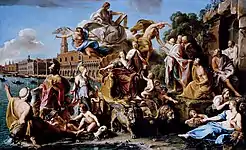
After losing to the league's forces at the Battle of Agnadello, Venice found its holdings in Italy shrinking drastically. Soon Padua, Venice's most strategically vital Terraferma holding, had fallen, and Venice itself was threatened. Loredan united the population, calling for sacrifice and total mobilisation. Padua was retaken, though Venice was still forced to accept a reluctant peace, following which it joined the Pope as only a junior ally in his new war against the French. The alliance was on the verge of victory, but a dispute arose over territory. Emperor Maximilian refused to surrender any Imperial territory, which in his eyes included most of the Veneto, to the Republic; to this end, he signed an agreement with the Pope to exclude Venice entirely from the final partition. When the Republic objected, Julius threatened to reform the League of Cambrai. In response, Venice turned to Louis; on 23rd March 1513, a treaty pledging to divide all of northern Italy between France and the Republic was signed at Blois. Under this alliance with the French King Louis XII, the Venetians achieved a decisive victory over the Papal states, and were able to secure back all the territories they had lost. In addition, the Papacy was forced to repay many outstanding debts to the Loredan family totaling approximately 500,000 ducats, an enormous sum of money.
_-_Monument_of_doge_Leonardo_Loredan.jpg.webp)
Leonardo Loredan died in Venice on the 22nd of June, 1521. The death, which occurred between eight and nine, was kept secret until sixteen at the behest of the children who, during their father's agony, had no regard for transporting furniture and objects from the doge's apartment to their residence. As is customary, the body was subjected to embalming practices. On the morning of June 23rd, after the body was moved to the Piovego room of the Doge's Palace, the coffin was closed. At the solemn funeral the eulogy was read by the scholar Andrea Navagero, and Pietro Bembo, then abbot and secretary of Pope Leo X, was also present.[2]
Loredan died "with great fame as a prince".[3] He was interred in the church of Santi Giovanni e Paolo, in a simple tomb with a celestial marble headstone without inscription, placed above the steps of the main altar and now no longer existing. In about 1572, and after some disputes between the heirs and the friars of the church, a funeral monument was erected for him, divided into three parts and adorned with Corinthian columns in Carrara marble, placed to the left of the main altar, with architecture by Girolamo Grappiglia , and adorned with an extremely lifelike statue, an early work by the sculptor Girolamo Campagna, which depicts him in the act of "getting up and boldly throwing himself in defence of Venice against Europe conspired in Cambrai". On its right was the statue of Venice with sword in hand and on the left that of the League of Cambrai, with the shield adorned with the heraldic coats of arms of the opposing powers (these, and the others in the monument were done by Danese Cattaneo, a pupil of Sansovino).
Leonardo Loredan was succeeded by Doge Antonio Grimani in 1521, who was married to Leonardo’s sister, Dogaressa Caterina Loredan: “The Loredanian tradition for patriotism and nobility was handed on in the gracious personage of Dogaressa Caterina Loredan, sister of Doge Leonardo Loredan – the Consort of his successor Doge Antonio Grimani.”[3]
In 1535, Venice ceded the town of Barban in Istria (today part of Croatia) to the Loredan family, which had acquired it in an auction, as a heritable possession. The family made it their summer residence.
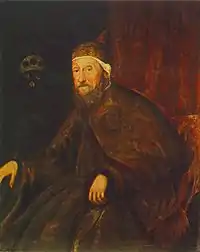
Pietro Loredan, born in 1482, became the 84th Doge of Venice and the second doge that the Loredan family gave. He was the third son of Alvise di Polo di Francesco Loredan, and his mother, Isabella Barozzi, came from one of the oldest Venetian noble families. Pietro had an intense but not necessarily prestigious political career, which he accompanied with the care of commercial interests according to the family tradition. Pietro married Maria Pasqualigo, and then Maria Lucrezia di Lorenzo Capello, with whom he had a son, Alvise Loredan (1521-1593), who continued the lineage with numerous offspring.[4]
Present in 1509 and in 1510 in the defense of Padua and Treviso, he made his debut in public life in 1510 as a sopracomito. In April 1511 he was elected a Senator, and he intervened in the Senate, asking for the reduction of the sum that the Jews had to pay for their "conduct" and ruled in favor of a league with France, also willing to sell Cremona and Ghiara d'Adda in exchange for other territories. In 1513 he left again to defend Padua and Treviso and, available for military roles, he offered to fill the positions of administrator of the Stradioti and the administrator of Adria. He refused his appointment as consul in Alexandria in 1516, when he intensified his entrepreneurial activity: in 1517 Pietro, together with his brothers, armed a ship to transport pilgrims to the Holy Land and the following year he set up a market galley on the Alexandria route.
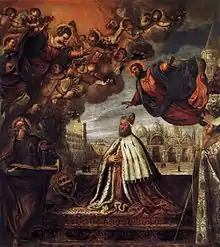
Business did not, however, distract him from public service, as evidenced by the various candidacies and the appointment in the College of the Twenty Wise Men, while his financial fortune allowed him to enter the committee of guarantors of Banco Priuli. In 1545 he was one of the nine electors of Doge Francesco Donà; between 1546 and 1549 he ran several times for the Council of Ten, in which, after another stint in the Senate (1549), he entered at the beginning of 1550, becoming its head. Later in the year he became ducal councilor for the Dorsoduro district. In the 1550s, Pietro consolidated his personal prestige, sat assiduously in the Senate, in the Council of Ten, as well as in the Signoria as ducal councilor. In 1559 he was included among the forty-one electors of Doge Girolamo Priuli.
On the 29th of November, 1567 he was elected doge, which came as a surprise for him. "A man of 85 years, but very prosperous.", wrote of him the papal nuncio Giovanni Antonio Facchinetti, who would later become Pope Innocent IX. Considered a figure of little political importance, his dogeship was considered the most suitable because it was transitory and politically harmless. Religious and morally upright, educated, and of uncommon wisdom, Pietro was reluctant at the beginning, but in the two and a half years of his reign showed recognized qualities of balance and prudence.[4]
Pietro Loredan died on the 3rd of May, 1570. On the 7th, the state funeral was organised in San Marco, instead of Santi Giovanni e Paolo, due to bad weather. Pietro’s body was carried in the cloister of S. Giobbe and buried in the family ark.
Doge Pietro Loredan was portrayed in the ducal palace by Domenico Tintoretto and the painting placed in the Senate room, and by Jacopo Tintoretto for the one in the Scrutinio room.
17th century
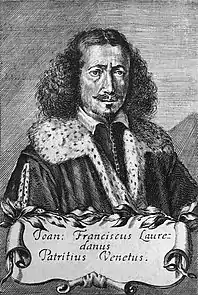
Giovanni Francesco Loredan, born in 1607, was a writer and politician. He was born in Venice as the son of Lorenzo Loredan and Leonora Boldù. When both of his parents died while he was very young, he was raised by his uncle Antonio Boldù and had as his teacher Antonio Colluraffi.
He divided his youth between hard study and an extravagant lifestyle. He attended the classes of renowned Aristotelian philosopher Cesare Cremoni in Padua and began, before 1623, to gather around him the group of scholars who then formed the Accademia degli Incogniti, also called the Loredanian academy. As founder of the Accademia degli Incogniti and a member of many other Academies, he had close contact with almost all the scholars of his time. He and his circle played a decisive role in the creation of modern opera. In addition to literary activity, he also took part in public affairs. At twenty he was recorded in the Golden Book, but his career began quite late: in September 1632 he was elected 'Savio agli Ordini' and in 1635 he was Treasurer of the fortress of Palmanova. On his return he reorganized the Accademia degli Incogniti (1636) and, in 1638, despite attempts to avoid it, he was obliged, as the only descendant of his branch, to contract marriage with Laura Valier. He was then Provveditore ai Banchi (1640), 'Provveditore alle Pompe' (1642), and in 1648 he made the leap to the rank of avogador del Comùn that he held several times (1651, 1656 and 1657) and 'Provveditore alle Biave'(1653). He subsequently joined the offices of the State Inquisitor and became a member of the Council of Ten. In 1656 he entered the Minor Consiglio, that is, among the six patricians who, together with the doge, composed the Serenissima Signoria. However, he may then have been pushed out of office, as in the following years he no longer held important positions. In 1660 he was a Provveditore in Peschiera. The following year (13th of August 1661) he died.
Dogaressa Paolina Loredan was the daughter of Lorenzo Loredan and wife of Doge Carlo Contarini, whom she married on the 22nd of February 1600 in the Church of San Polo. She was an “immensely stout woman and incredibly plain-looking”, and therefore she decided she would not appear in public due to fear of being mocked by the populace.[3] On the façade of the Church of San Vitale, Giuseppe Guoccola sculptured the busts of Doge Carlo and Dogaressa Paolina Loredan, placed there in gratitude of their noble bequests to the clergy.
In the second half of the century, Francesco Loredan (1656-1715) is notable as he was the Venetian ambassador to Vienna.
18th century
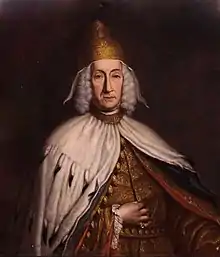
Francesco Loredan, born in 1685, was the 116th Doge of Venice and the third and last of the Loredan family. He served as Doge from the 18th of March 1752, until his death on the 19th of May 1762. Loredan was a man of modest culture and limited political experience, having been raised primarily for a life of commerce. Loredan was elected doge on the 18th of March 1752 but the announcement was made on the 6th of April, postponed because of Easter. By this point, the dogal figure had lost nearly all his power and he quickly adapted to this new situation. One of the biggest issues in domestic politics at the time was the clash between the conservatives and the reformers. The latter wanted to substantially reform the Republic and sought to build internal reforms. The conservative pressure groups were able to block these plans and imprisoned or exiled the reformist leaders, such as Angelo Querini, an important figure of the Venetian Enlightenment. The Doge did not want to show favour to one side or the other, so he remained totally passive and limited his support to making it easier for the winning side, thereby losing his chance to change the fate of the dying republic. By impeding the development of the reformist ideas, he possibly caused the small economic boom which started around 1756 with the outbreak of the Seven Years' War. The neutrality of the Republic during this time allowed the merchants to trade in huge markets without competitors. The French defeat even allowed Venice to become the biggest market for eastern spices. Interestingly, in 1752, Francesco offered the Palazzo Loredan dell'Ambasciatore as a residence for the ambassador of the Holy Roman Empire, and the first Imperial ambassador to live there was Count Philip Joseph Orsini-Rosenberg. In 1759, Loredan was awarded the Golden Rose by Pope Clement XIII, becoming the first and only doge to obtain the award. At one point the Doge, who was old and tired by then, seemed about to die but recovered and lived for another year, until his death on the 19th of May 1762. The funeral took place on May 25th, and he was buried in the basilica of Santi Giovanni e Paolo, in Leonardo Loredan’s Dogal tomb. The funeral cost an impressive sum of around 14,000 ducats.
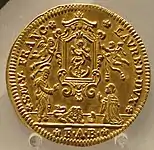
Interestingly, the famed author and adventurer Giacomo Casanova was locked in the notorious lead chambers under Francesco Loredan's government in 1755 for suspicious activities, from which he managed his spectacular escape.
During this time, the Loredan family was incredibly wealthy and owned numerous palaces.
The family branch of Santo Stefano ended in 1750 with Andrea di Girolamo Loredan.
19th century
After the fall of the Republic of Venice in 1797, some branches of the family were named on the basis of Venetian toponyms: San Luca, San Giovanni in Bragora, San Pantaleone, San Vio etc.
Antonio Francesco di Domenico Loredan held the title of count in the Austrian Empire, and his brothers were also listed in the official list of nobles.
Notable members
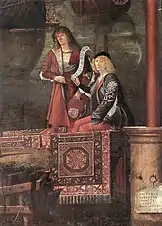
Alvise Loredan (1393–1466) was a Venetian politician and commander of the fleet.
Giacomo (Jacobus) Loredan, 1396-1471, was elected Procuratore di San Marco de Citra in 1467. [5]
Admiral Pietro Loredan (died 1439), a famous member of the family, achieved two great victories, against the two rivals for power in the Mediterranean: over the Ottoman Turks at the Battle of Gallipoli in June 1416, and over the Republic of Genoa near Rapallo in 1431. His attempt at being elected Doge of Venice was unsuccessful in 1423: he was defeated by his lifelong rival Francesco Foscari. Loredan was named general of the Republic in 1436 during a war with Mantua and was elected generalissimo in 1438, and was assassinated the following year.
Antonio Loredan (1420–1482) was a captain of Venetian-held Scutari and governor of Split, Albania Veneta, and a town in Morea. He is best known for the successful defense of Scutari in 1474.
Pietro Loredan was appointed captain of two Venetian galleys by Doge Nicolò Marcello in 1473-74.[6]
Tommaso Loredan was given a commission as captain of two Venetian galleys in 1490 by Doge Agostino Barbarigo.[7]
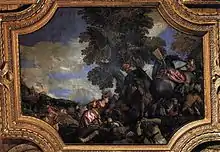
Bartolomeo Loredan, Girolamo Loredan and Zorzi Loredan were counts of Zara in the 17th and 18th centuries,[8] while Antonio, Luigi, Giacomo and Girolamo Loredan were among the counts of Spalato.[9]
Marco Loredan and Antonio Loredan were dukes of Morea in the 18th century.
Further politicians were Giacomo Loredan (1396–1471), Giorgio Loredan (before 1404–1475), Antonio Loredan (1446–1514), Marco Loredan (1489–1557), Giovanni Francesco Loredan (1607–1661), Francesco Loredan (1656–1715), ambassador to Vienna.
Among literary figures, Giovanni Francesco Loredan (1607–1661) is remembered for the Accademia degli Incogniti, also known as the Loredanian Academy, that he founded in 1630.
Doges of Venice
The family contributed three Doges: Leonardo Loredan (1501–1521), Pietro Loredan (1567–1570), and Francesco Loredan (1752–1762), of whom only the first truly set his mark on the history of Venice; the Portrait of Doge Leonardo Loredan by Giovanni Bellini (1501) makes his face familiar still.

.jpg.webp)
 Doge Francesco Loredan (1752–1762), by Fortunato Pasquetti
Doge Francesco Loredan (1752–1762), by Fortunato Pasquetti
Palaces
The Palazzo Loredan dell'Ambasciatore on the Grand Canal derived its popular name as the residence of the ambassador of the Holy Roman Empire, which was offered as a residence for the Imperial ambassador by Doge Francesco Loredan.
The great collector in the family was Andrea Loredan who constructed a palazzo on the Cannaregio to designs by Mauro Codussi; it was paid for by Doge Leonardo Loredan; it was bought in the eighteenth century by the Vendramin family, and the Ca' Loredan Vendramin Calergi is notable today for its association with Richard Wagner.[10]
Palazzo Loredan Cini, a Gothic style palace located on the Grand Canal, has a large collection of precious artworks which are on permanent display on the first floor of the palace.
Ca' Loredan, whose main facade features polifora windows, is today home to the city's municipal council.
The Palazzo Giustinian Loredan is still today owned by the family.
In the terraferma there are numerous Villas Loredan — at Strà on the Brenta Canal; at Paese, near Treviso, the villa painted by Francesco Guardi; at Asolo; at Sant'Urbano, near Padua. The domain of the Villa Loredan at Paese was planted with grapevines in the 1950s by Conte Pietro Loredan; the wine continues to be made under the label Conte Loredan Gasparini.[11]
.jpg.webp)
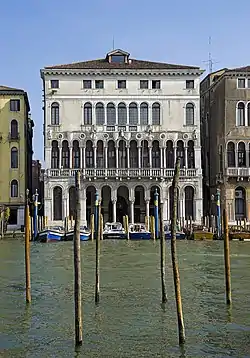
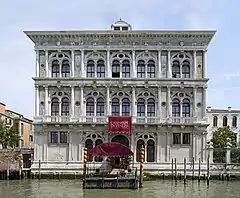 Ca' Vendramin Calergi on the Grand Canal, built for Andrea Loredan
Ca' Vendramin Calergi on the Grand Canal, built for Andrea Loredan.jpg.webp) Palazzo Priuli Ruzzini Loredan
Palazzo Priuli Ruzzini Loredan2.jpg.webp) Palazzo Loredan in Campo S. Stefano
Palazzo Loredan in Campo S. Stefano.jpg.webp)
.jpg.webp) Palazzo Giustinian Loredan
Palazzo Giustinian Loredan.jpg.webp) Palazzo Loredan in Santa Marina
Palazzo Loredan in Santa Marina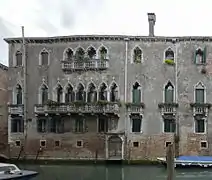 Palazzo Loredan Gheltoff
Palazzo Loredan Gheltoff_(Sant'Urbano).jpg.webp) Villa Nani Loredan in Sant'Urbano
Villa Nani Loredan in Sant'Urbano
In art
Istria
On the 23rd of December, 1535, the Loredan family acquired the town of Barban in Istria (today part of Croatia) for 14,760 ducats, and ownership was held by the brothers Leonardo, Lorenzo and Francesco.
At the time, Barban also included Rakalj, and the two territories were organized as a separate feud owned by the Loredan family, who owned it until the abolition of feudal rights in 1869.
In 1606, the already existing castle in Barban was transformed into the family palace that still holds the Loredan coat of arms to this day.
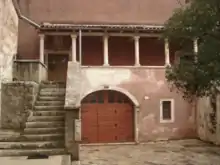
The family managed the feud through their officer who held the title of captain.
“The Loredan Terminations” were written orders of the Loredan family. They were created for the purpose of communication between the masters who were in Venice and the family representatives in Istria. From them we can learn about the internal structure of the feud. The captain had political and judicial power, and was appointed by the Loredans. He had to reside permanently on the estate and participate in the election of prefects, deputy prefects and other officials. He had a chancellor who recorded all the documents in special books, and he also took care of the distribution of grain. Twelve judges, the prefect and the deputy prefect took care of the supply, solved smaller disputes and imposed lesser sentences. Church and fraternal goods were managed by the gastald and the municipal money was collected by the chamberlain. The Loredan terminations also deal with the prohibition of deforestation, management of municipal property, maintenance of cleanliness, burial of the dead, running of the fair, teaching of religion, civil law provisions, etc.
Dalmatia
.jpg.webp)
Besides Istria, the family also made their mark in Dalmatia.
Bartolomeo Loredan, Girolamo Loredan and Zorzi Loredan were counts of Zara in the 17th and 18th centuries,[8] where they would have resided in the Rector's Palace.
Antonio, Luigi, Girolamo and Giacomo Loredan were among the counts of Spalato.[9]
The family is also mentioned on the Dalmatian island of Ugljan.
Throughout history, members of the family were also influential in numerous other Dalmatian towns and cities.
Conte Loredan Gasparini winery
The Conte Loredan Gasparini winery was founded in the 1950s by Count Piero Loredan, descendant of the Doge of Venice Leonardo Loredan, who chose the territory of Vignigazzu to establish his home in a grand Palladian villa - The Villa Loredan at Paese.[11]

The winery is located in Venegazzù di Volpago del Montello, in the Veneto region, in the heart of the Marca Trevigiana, an area famous for the production of wines since the 16th century.
Loredan family in art
In painting


_-_WGA16910.jpg.webp) Allegory of the Victory over the League of Cambrai, by Palma il Giovane, 1590, featuring Doge Leonardo Loredan, Doge's Palace, Venice
Allegory of the Victory over the League of Cambrai, by Palma il Giovane, 1590, featuring Doge Leonardo Loredan, Doge's Palace, Venice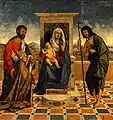 The Virgin with Child and Saints adored by Doge Leonardo Loredan, by Vincenzo Catena, 1506, Doge's Palace, Venice
The Virgin with Child and Saints adored by Doge Leonardo Loredan, by Vincenzo Catena, 1506, Doge's Palace, Venice
 The Triumph of Venice, by Pompeo Batoni, 1737, featuring Doge Leonardo Loredan, North Carolina Museum of Art, Raleigh
The Triumph of Venice, by Pompeo Batoni, 1737, featuring Doge Leonardo Loredan, North Carolina Museum of Art, Raleigh.jpg.webp)


 Portrait of Giovanni Francesco Loredan, by Giacomo Piccini
Portrait of Giovanni Francesco Loredan, by Giacomo Piccini Portrait of Giovanni Francesco Loredan, by Daniel van den Dyck
Portrait of Giovanni Francesco Loredan, by Daniel van den Dyck Portrait of Doge Francesco Loredan, by Fortunato Pasquetti
Portrait of Doge Francesco Loredan, by Fortunato Pasquetti Portrait of Doge Francesco Loredan, by Jacopo Guarana
Portrait of Doge Francesco Loredan, by Jacopo Guarana Portrait of Doge Francesco Loredan, by Antonio Nani
Portrait of Doge Francesco Loredan, by Antonio Nani Antonio Loredan (on the right) and a Young Man, by Vittore Carpaccio, 1495, Gallerie dell'Accademia, Venice
Antonio Loredan (on the right) and a Young Man, by Vittore Carpaccio, 1495, Gallerie dell'Accademia, Venice
In sculpture
_-_Statue_of_doge_Leonardo_Loredan.jpg.webp) Statue of Doge Leonardo Loredan, by Girolamo Campagna, 1572, Basilica of Santi Giovanni e Paolo, Venice
Statue of Doge Leonardo Loredan, by Girolamo Campagna, 1572, Basilica of Santi Giovanni e Paolo, Venice

 Doge Leonardo Loredan at the Feet of the Virgin with Saints, by Pietro Lombardo, Doge's Palace, Venice
Doge Leonardo Loredan at the Feet of the Virgin with Saints, by Pietro Lombardo, Doge's Palace, Venice_-_Monument_of_doge_Leonardo_Loredan.jpg.webp) Tomb of Doge Leonardo Loredan, by Girolamo Grapiglia, 1572, Basilica of Santi Giovanni e Paolo, Venice
Tomb of Doge Leonardo Loredan, by Girolamo Grapiglia, 1572, Basilica of Santi Giovanni e Paolo, Venice
Notes
- "LOREDAN in "Enciclopedia Italiana"". www.treccani.it (in Italian). Retrieved 2021-01-16.
- "LOREDAN, Leonardo in "Dizionario Biografico"". www.treccani.it (in Italian). Retrieved 2021-01-16.
- Staley, Edgcumbe (1910). The Dogaressas of Venice: The Wives of the Doges. 1910: T.W. Laurie.CS1 maint: location (link)
- "LOREDAN, Pietro in "Dizionario Biografico"". www.treccani.it (in Italian). Retrieved 2021-01-16.
- Venice, Biblioteca del Museo Correr, ms. Classe III 13; see also Dizionario biografico degli italiani, 1960-.
- Commission of Doge Nicolò Marcello, 1473-74, in Venice, Museo Correr, ms. Classe III 43, document description and first page online at nuovabibliotecamanoscritta,
- Paris, Bibliothèque nationale de France, MS. Lat.4730.
- De Benvenuti, Angelo. Storia di Zara dal 1409 al 1797. Milan.
- Romanin, Samuele. Storia documentata della Repubblica di Venezia. Venice.
- Berendt, John (2005). The City of Falling Angels. Penguin Press. ISBN 1-59420-058-0.
- Conte Loredan Gasparini

